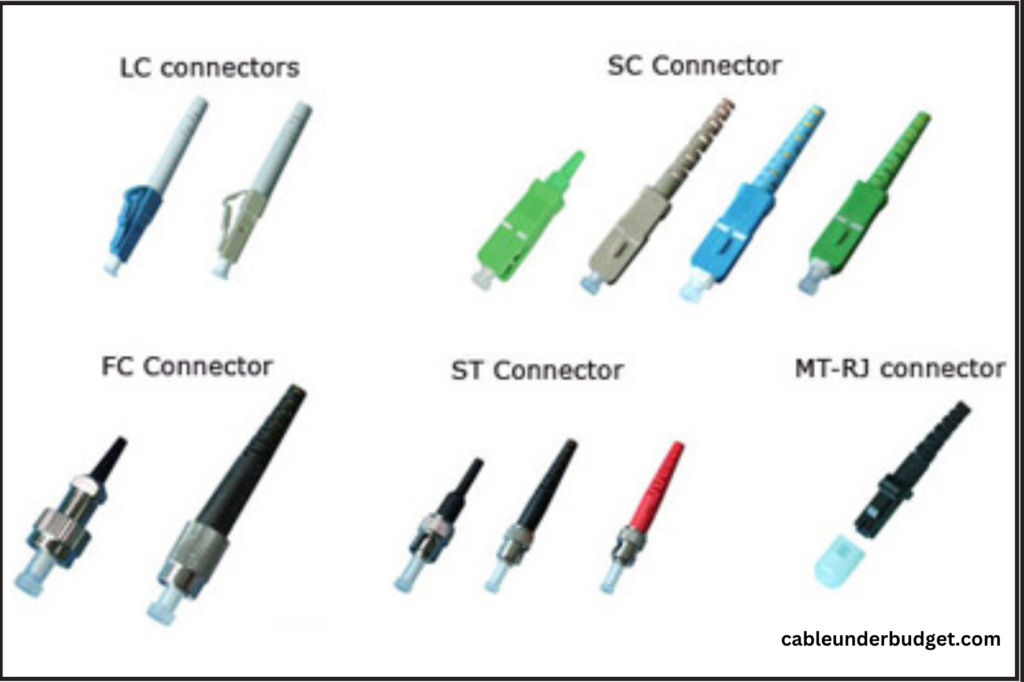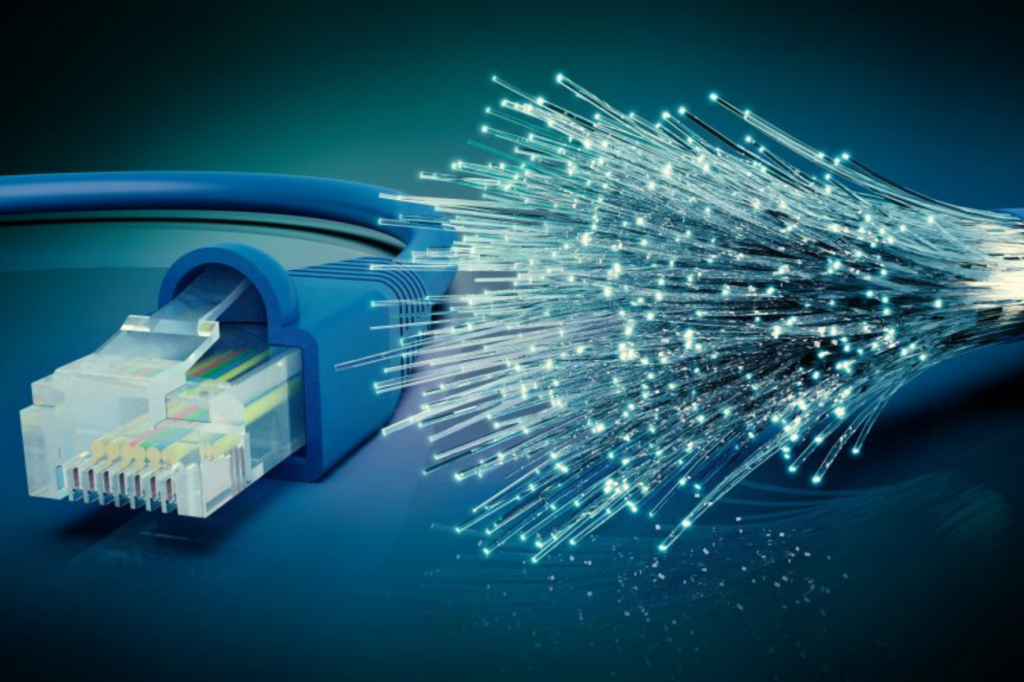Contents
- 1 Fiber Optic Connectors and Plug Types
- 1.1 ST Connector (Straight Tip Connector):
- 1.2 SC Connector (Subscriber Connector):
- 1.3 FC Connector (Ferrule Connector):
- 1.4 MTP/MPO Connector (Multi-Fiber Push-On/Pull-Off):
- 1.5 MT-RJ Connector (Mechanical Transfer-Registered Jack):
- 1.6 LC Connector (Lucent Connector):
- 1.7 DIN Connector:
- 1.8 E2000 Connector:
Fiber Optic Connectors and Plug Types
Fiber optic connectors and plug types refer to the physical components used to connect optical fibers together to enable the transmission of data through light signals. These connectors and plugs ensure secure and reliable connections between optical fibers, allowing for efficient data transmission in various applications such as telecommunications, networking, and data centers.

Fiber optic connectors typically consist of a ferrule, which holds the fiber in place, and a coupling mechanism that enables the connection to another fiber or device. The plug refers to the male connector that is inserted into a corresponding female receptacle to establish a connection.
There are several types of fiber optic connectors and plug types, each with its own design, features, and applications. Some common types include:
- ST Connector (Straight Tip Connector)
- SC Connector (Subscriber Connector)
- LC Connector (Lucent Connector)
- FC Connector (Ferrule Connector)
- MTP/MPO Connector (Multi-Fiber Push-On/Pull-Off)
- MT-RJ Connector (Mechanical Transfer-Registered Jack)
- DIN Connector
- E2000 Connector
These connectors and plug types vary in terms of size, coupling mechanism, performance characteristics, and suitability for different applications. Choosing the right connector and plug type depends on factors such as the specific application requirements, environmental conditions, and compatibility with existing equipment.
ST Connector (Straight Tip Connector):
- The ST connector is one of the earliest types of fiber optic connectors, widely used in networking and telecommunications.
- It features a bayonet-style coupling mechanism, where the connector is inserted and twisted to lock it into place securely.
- ST connectors are known for their durability and reliability, making them suitable for both single-mode and multi-mode fiber applications.
- They are often utilized in environments where frequent connection and disconnection are necessary, such as in LANs and telecommunication systems.
SC Connector (Subscriber Connector):
- The SC connector is popular for its simple and efficient push-pull coupling mechanism, allowing for quick installation and removal without any special tools.
- It provides low insertion loss and high repeatability, making it suitable for high-speed data transmission applications.
- SC connectors are widely used in Ethernet networks, fiber to the home (FTTH) installations, and cable television (CATV) systems due to their reliability and ease of use.

FC Connector (Ferrule Connector):
- The FC connector utilizes a threaded coupling mechanism, providing a stable and secure connection suitable for demanding environments.
- It is commonly used in applications where reliability and precision are paramount, such as in military, aerospace, and high-speed data transmission systems.
- FC connectors are known for their robustness and resistance to vibration, making them suitable for industrial and outdoor installations.
- They are also favored in test and measurement equipment due to their repeatability and low insertion loss.
MTP/MPO Connector (Multi-Fiber Push-On/Pull-Off):
- MTP/MPO connectors allow for the simultaneous connection of multiple fibers within a single connector, enabling high-density cabling solutions.
- They are widely used in data center environments for applications like high-speed parallel optics, backbone networks, and server-to-switch connections.
- MTP/MPO connectors offer quick and easy installation, reducing labor costs and simplifying cable management.
- They provide scalability and flexibility, allowing for easy expansion and reconfiguration of network infrastructure as needed.
MT-RJ Connector (Mechanical Transfer-Registered Jack):
- The MT-RJ connector combines two fibers into a single, compact connector, effectively reducing space requirements and simplifying cable management.
- It is commonly used in duplex fiber optic links, such as those found in LANs and residential installations.
- MT-RJ connectors feature a small form factor and a push-pull latching mechanism for easy installation and removal.
- They are ideal for applications requiring high-density connections, such as patch panels and network interface cards (NICs).
LC Connector (Lucent Connector):
- The LC connector is a small form factor (SFF) connector designed for high-density applications and space-constrained environments.
- It features a latch mechanism for easy insertion and removal, ensuring a secure connection.
- LC connectors offer excellent performance with low insertion loss and high return loss, making them ideal for data centers, enterprise networks, and telecommunications.
- They are often used in applications requiring duplex connections, such as transceivers and patch panels.

DIN Connector:
- DIN connectors are ruggedized connectors commonly used in industrial applications and harsh environments.
- They feature a circular design with a threaded coupling mechanism, ensuring a secure and reliable connection.
- DIN connectors are resistant to dust, moisture, and vibration, making them suitable for manufacturing environments, industrial automation systems, and outdoor installations.
- They are available in various configurations, including single-mode and multi-mode fibers, to accommodate different requirements and applications.

E2000 Connector:
- The E2000 connector is known for its high-performance capabilities, including low insertion loss, high return loss, and excellent repeatability.
- It features a push-pull latching mechanism for easy and secure connections, making it suitable for demanding applications.
- E2000 connectors are often used in telecommunications networks, medical equipment, and high-speed data transmission systems.
- They offer enhanced reliability and precision, making them ideal for critical applications where signal integrity is essential.

